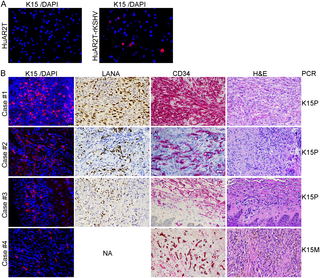PLoS Pathogens ( IF 5.5 ) Pub Date : 2017-09-22 , DOI: 10.1371/journal.ppat.1006639 Bizunesh Abere , Tamrat M. Mamo , Silke Hartmann , Naira Samarina , Elias Hage , Jessica Rückert , Sven-Kevin Hotop , Guntram Büsche , Thomas F. Schulz

|
Kaposi’s sarcoma-associated herpesvirus (KSHV) is the infectious cause of the highly vascularized tumor Kaposi’s sarcoma (KS), which is characterized by proliferating spindle cells of endothelial origin, extensive neo-angiogenesis and inflammatory infiltrates. The KSHV K15 protein contributes to the angiogenic and invasive properties of KSHV-infected endothelial cells. Here, we asked whether K15 could also play a role in KSHV lytic replication. Deletion of the K15 gene from the viral genome or its depletion by siRNA lead to reduced virus reactivation, as evidenced by the decreased expression levels of KSHV lytic proteins RTA, K-bZIP, ORF 45 and K8.1 as well as reduced release of infectious virus. Similar results were found for a K1 deletion virus. Deleting either K15 or K1 from the viral genome also compromised the ability of KSHV to activate PLCγ1, Erk1/2 and Akt1. In infected primary lymphatic endothelial (LEC-rKSHV) cells, which have previously been shown to spontaneously display a viral lytic transcription pattern, transfection of siRNA against K15, but not K1, abolished viral lytic replication as well as KSHV-induced spindle cell formation. Using a newly generated monoclonal antibody to K15, we found an abundant K15 protein expression in KS tumor biopsies obtained from HIV positive patients, emphasizing the physiological relevance of our findings. Finally, we used a dominant negative inhibitor of the K15-PLCγ1 interaction to establish proof of principle that pharmacological intervention with K15-dependent pathways may represent a novel approach to block KSHV reactivation and thereby its pathogenesis.
中文翻译:

卡波济氏肉瘤相关疱疹病毒(KSHV)非结构膜蛋白K15是病毒裂解复制所必需的,可能代表治疗靶点
卡波西氏肉瘤相关疱疹病毒(KSHV)是高度血管化肿瘤卡波西氏肉瘤(KS)的感染原因,其特征是内皮源性梭形细胞增生,广泛的新血管生成和炎性浸润。KSHV K15蛋白有助于感染KSHV的内皮细胞的血管生成和侵袭特性。在这里,我们询问K15是否也可以在KSHV裂解复制中发挥作用。从病毒基因组中删除K15基因或通过siRNA去除K15基因会导致病毒重新激活减少,这由KSHV裂解蛋白RTA,K-bZIP,ORF 45和K8.1的表达水平降低以及传染性物质释放降低所证明病毒。对于K1缺失病毒也发现了相似的结果。从病毒基因组中删除K15或K1也损害了KSHV激活PLCγ1,Erk1 / 2和Akt1的能力。先前已显示在感染的原发性淋巴内皮细胞(LEC-rKSHV)中自发显示病毒裂解转录模式,针对K15而不是K1的siRNA转染消除了病毒裂解复制以及KSHV诱导的纺锤体细胞形成。使用新产生的针对K15的单克隆抗体,我们在从HIV阳性患者获得的KS肿瘤活检物中发现了丰富的K15蛋白表达,强调了我们发现的生理意义。最后,











































 京公网安备 11010802027423号
京公网安备 11010802027423号